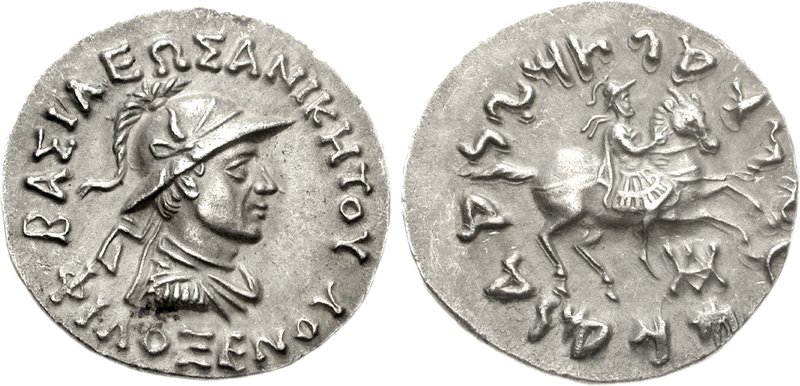Philoxenios on:
[Wikipedia]
[Google]
[Amazon]
 Philoxenus Anicetus ( Greek: ;
Philoxenus Anicetus ( Greek: ;
 One overstrike is known, of
One overstrike is known, of
File:PhyloxenusCoin1.JPG, Philoxenus on horse.
File:Philoxenus Indo Greek square coin.jpg, Philoxenus coin in the Indian square standard. Japan Currency Museum.
File:Whitehead Coins of the Punjab Museum Plate VII Phyloxenos.jpg, Coin of Phyloxenos.
Coins of Philoxenus
Ancient history of Pakistan Indo-Greek kings 1st-century BC rulers in Asia {{AncientGreece-bio-stub
 Philoxenus Anicetus ( Greek: ;
Philoxenus Anicetus ( Greek: ; epithet
An epithet (, ), also byname, is a descriptive term (word or phrase) known for accompanying or occurring in place of a name and having entered common usage. It has various shades of meaning when applied to seemingly real or fictitious people, di ...
means "the Invincible") was an Indo-Greek king who ruled in the region spanning the Paropamisade to Punjab. Philoxenus seems to have been quite an important king who might briefly have ruled most of the Indo-Greek territory. Bopearachchi dates Philoxenus to c. 100–95 BCE and R. C. Senior to c. 125–110 BCE.
Historians have not yet connected Philoxenus with any dynasty, but he could have been the father of the princess Kalliope, who was married to the king Hermaeus.
Coins of Philoxenos
Philoxenus struck several series of bilingual Indian silver coins, with a reverse of a mounted king, a type previously used as obverse by Antimachus II sixty years earlier and as reverse on rare types of Nicias. Whether the horseman was a dynastic emblem or a portrait of the king as a cavalryman is unclear. Several Saka kings used similar horsemen on their coinage. His drachms were square, another feature that was rare among Indo-Greeks but standard for Sakas, and this indicates that Philoxenus had connections with the nomads that had conquered Bactria. Philoxenus struck bronzes with female deity/bull, orHelios
In ancient Greek religion and Greek mythology, mythology, Helios (; grc, , , Sun; Homeric Greek: ) is the deity, god and personification of the Sun (Solar deity). His name is also Latinized as Helius, and he is often given the epithets Hyper ...
/ Nike.
Philoxenus also minted some Attic-type tetradrachms (with Greek legend only), meant for circulation in Bactria.
Overstrikes
 One overstrike is known, of
One overstrike is known, of Epander
Epander (Greek: ) was one of the Indo-Greek kings. He may have been a relative of Menander I, and the findplaces of his coins seem to indicate that he ruled in the area of Punjab.
Time of reign
Bopearachchi dates Epander to c. 95–90 BC and R. ...
over Philoxenus.
Other coins
See also
*Greco-Bactrian Kingdom
The Bactrian Kingdom, known to historians as the Greco-Bactrian Kingdom or simply Greco-Bactria, was a Hellenistic period, Hellenistic-era Hellenistic Greece, Greek state, and along with the Indo-Greek Kingdom, the easternmost part of the Helleni ...
* Seleucid Empire
The Seleucid Empire (; grc, Βασιλεία τῶν Σελευκιδῶν, ''Basileía tōn Seleukidōn'') was a Greek state in West Asia that existed during the Hellenistic period from 312 BC to 63 BC. The Seleucid Empire was founded by the ...
* Greco-Buddhism
* Indo-Scythians
* Indo-Parthian Kingdom
* Kushan Empire
The Kushan Empire ( grc, Βασιλεία Κοσσανῶν; xbc, Κυϸανο, ; sa, कुषाण वंश; Brahmi: , '; BHS: ; xpr, 𐭊𐭅𐭔𐭍 𐭇𐭔𐭕𐭓, ; zh, 貴霜 ) was a syncretic empire, formed by the Yuezhi, i ...
References
* ''The Greeks in Bactria and India'', W. W. Tarn, Cambridge University Press.External links
Coins of Philoxenus
Ancient history of Pakistan Indo-Greek kings 1st-century BC rulers in Asia {{AncientGreece-bio-stub